Sheep Feedlots
The use of intensive finishing systems (also known as confined paddock feeding and feedlotting) for lambs and sheep is steadily increasing in Australia, mainly due to continued demand for lamb export. Animals housed in feedlots are fed grain diets and require considerably less space than animals being pasture fed. These systems are also being utilised to maximise profits within the 'prime lamb' industry.
'Grain finishing involves financial risk, in particular lamb deaths, shy feeders and unexpected changes in market prices for lambs and feed.' – Agriculture Victoria
Sheep sentience
A study by Universities Foundation for Animal Welfare proved, unsurprising to anyone who has spent time with them, that sheep feel a wide range of emotions, just like we, or our companion dogs and cats do.
'It is concluded that sheep are able to experience emotions such as fear, anger, rage, despair, boredom, disgust and happiness because they use the same checks involved in such emotions as humans. For instance, despair is triggered by situations which are evaluated as sudden, unfamiliar, unpredictable, discrepant from expectations, and uncontrollable, whereas boredom results from an overly predictable environment, and all these checks have been found to affect emotional responses in sheep.
Sheep release high levels of cortisol, the primary stress hormone, the same way humans do, in frightening circumstances. Studies have shown the release of cortisol in sheep awaiting their death in abattoirs, during shearing and during painful mutilations like tail docking.

Newborn lambs just like this one deserve safety, but instead are subjected to painful mutilation.
Lack of legal protection
In the wool industry, sheep, as with all farmed animals, are not legally protected from cruelty like dogs or cats are. This is because in the Victorian Prevention of Cruelty to Animals Act (POCTAA) and equivalent legislation in other states, farmed animals are specifically exempt from such safeties and protections.
As it stands currently, even 'codes of practice' for accepted farming methods for sheep are not mandatory to follow. Because of this lack of protection, there is almost no holding the wool industry accountable for the cruelties discussed below, or any other.
Exports
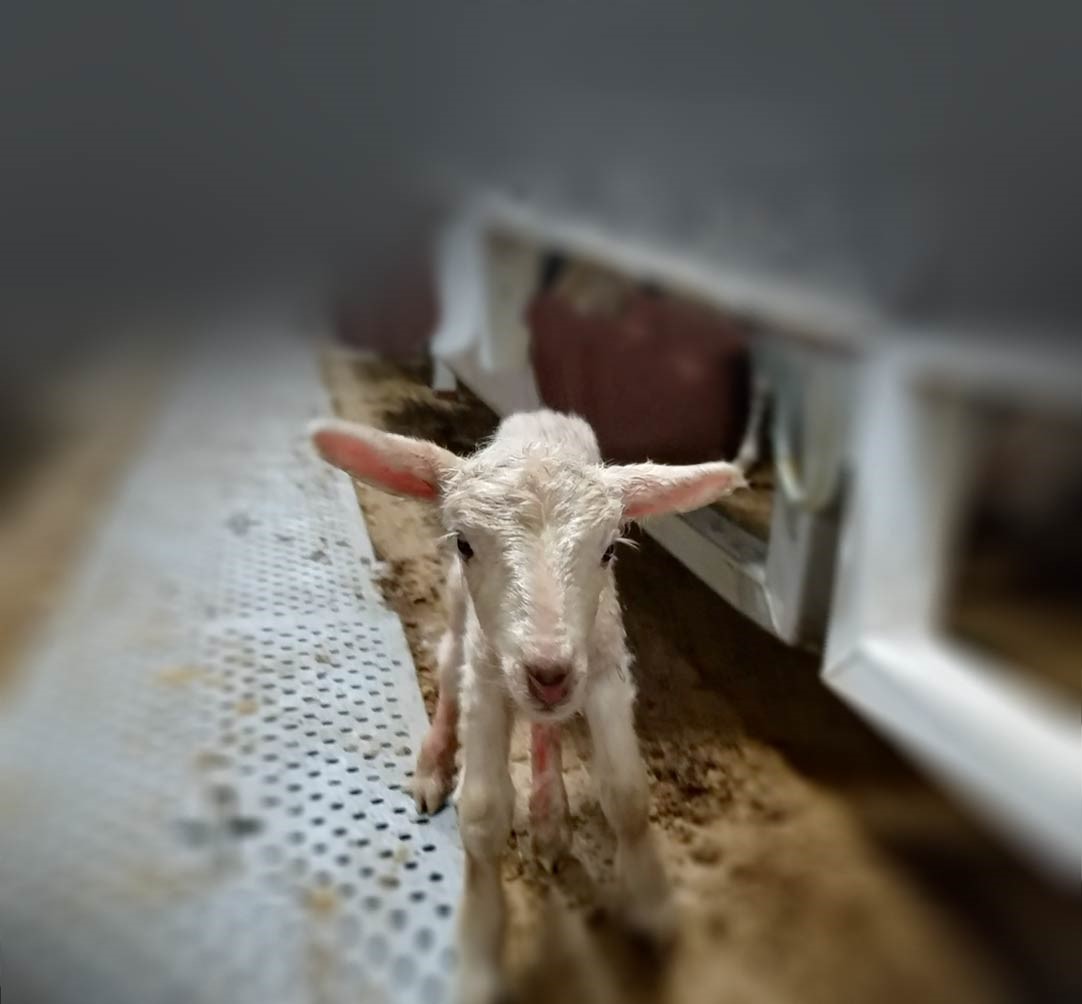 |
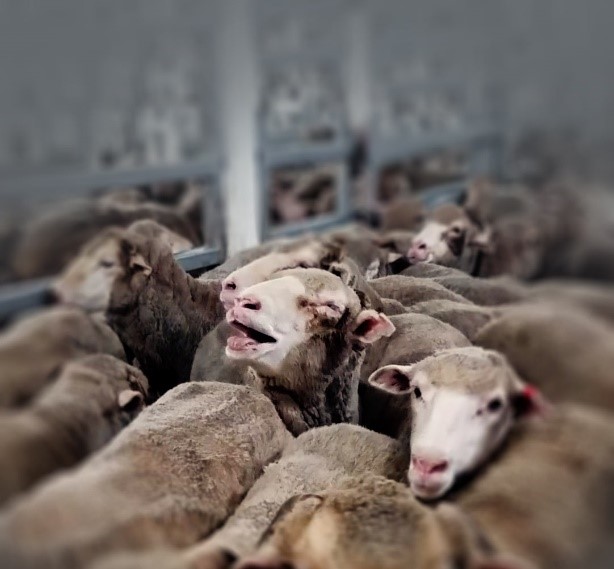 |
Sheep aboard a live export sheep from Australia. Source: Animals Australia
Live export:
Australia is a major exporter of live animals. According to LiveCorp, which reports on livestock export data from the Australian Bureau of Statistics, 1,168,281 animals were exported by sea and air in 2024, including 430,505 sheep. The export of sheep alone was valued at over $44 million.
In 2024, Australia's largest markets for live sheep exports were Kuwait, which received 138,731 sheep (32%), Jordan with 127,000 sheep (30%) and Saudi Arabia with 122,500 sheep (29%).
Some vessels have the capacity to carry up to 85,000 sheep in one voyage. Animals Australia have on numerous occasions exposed the hidden truth aboard live export ships, as well as cruelty suffered by Australian animals overseas.
The Australian Government's decision to phase out live sheep exports by sea by 1st May 2028, followed extensive consultation and analysis led by an independent panel appointed in March 2023. The panel reviewed over 800 written submissions, 3,300 survey responses, existing data and commissioned analyses before submitting its final report to the government on 25 October 2023. While the phase out marks a significant step for animal welfare, live exports of cattle, goats and buffalo will continue.
Kuwait investigation: Animals Australia 2015
Meat export:
In 2021-2022, Australia exported a record $4.5 billion worth of sheepmeat, driven largely by strong increases in the average export prices of lamb (up 21%) and mutton (up 19%) compared with the previous three-year average. The United States was Australia's largest market by value, while China remained the largest by volume. Globally, Australia accounts for 34% of sheepmeat exports, making them one of the largest exporting countries worldwide.
.png)
The Industry:
Alliances between sheep breeders and processing facilities are also attributing to the rise of permanent feedlots. Some specialist breeders in high rainfall grazing areas have identified feedlotting as a way to increase profits by maximising stocking rates and selling store lambs to intensive finishers. In addition to this, some processors (slaughterhouses/abattoirs) buy lambs and forward them to finishers to ensure they have a constant supply of lambs of the quality they have deemed 'desirable'.
Space allowances
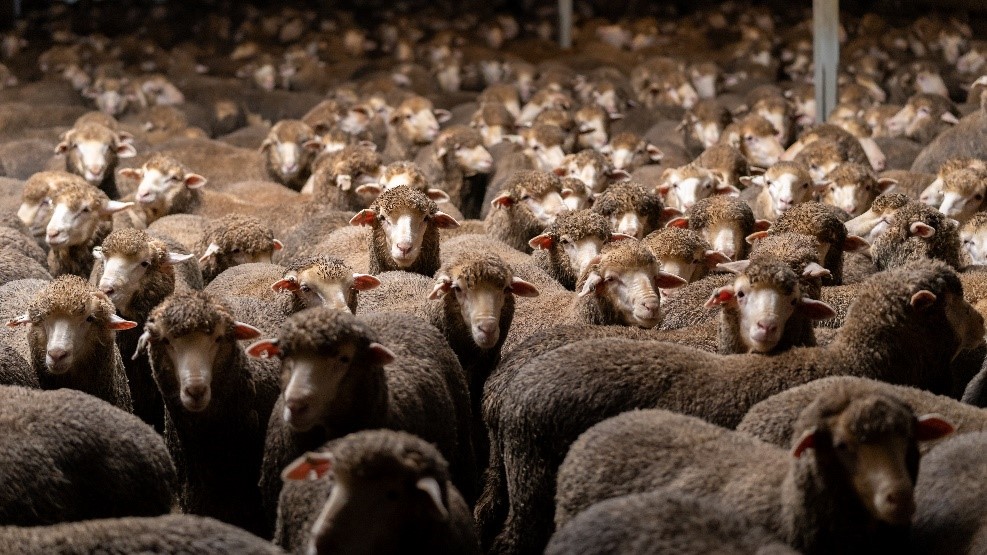
The current minimum area required for sheep and lambs in intensive confinement systems, with a liveweight of 40-55kgs, is 0.5 square meters per head. This means that in a pen that is 20mx20m up to 800 sheep or lambs could legally be housed together. Further, Meat and Livestock Australia state on their website that the optimum stocking densities for both indoor and outdoor feedlotting systems is undetermined, suggesting a huge deficiency in knowledge and governance regarding the welfare and wellbeing of animals kept in them.
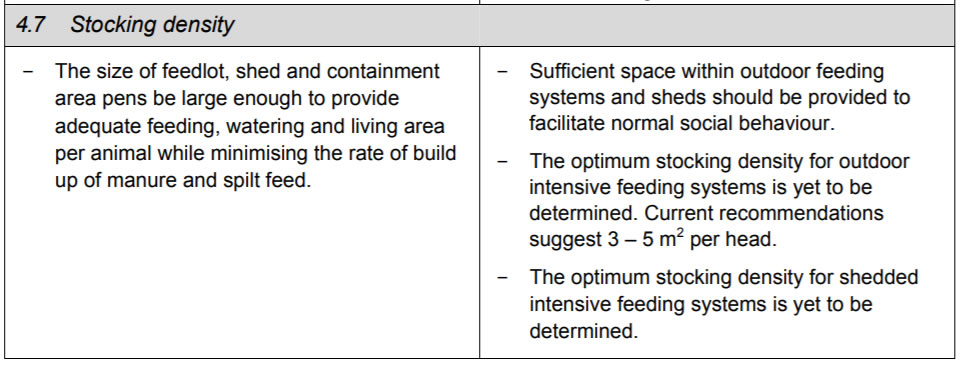
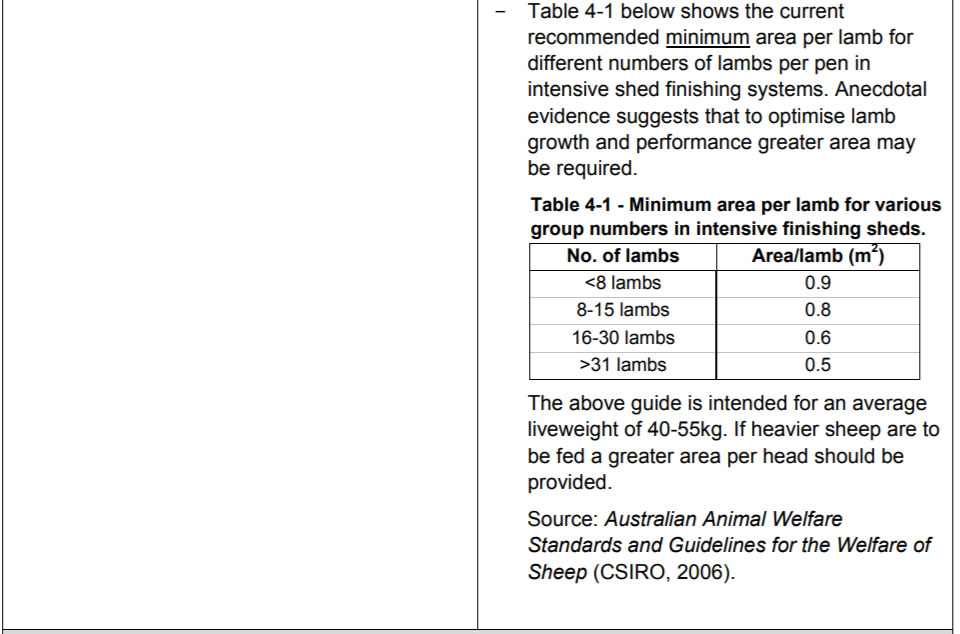
(Stocking Densities. Source: Meat and Livestock Australia)
Health implications for sheep
There are a number of health implications associated with finishing lambs and sheep in feedlots, many due to the use of high grain, low fibre diets, or the sudden change in diet. Indoor feedlots with metal flooring also have regular occurrences of lame sheep who are suffering leg or feet injuries.
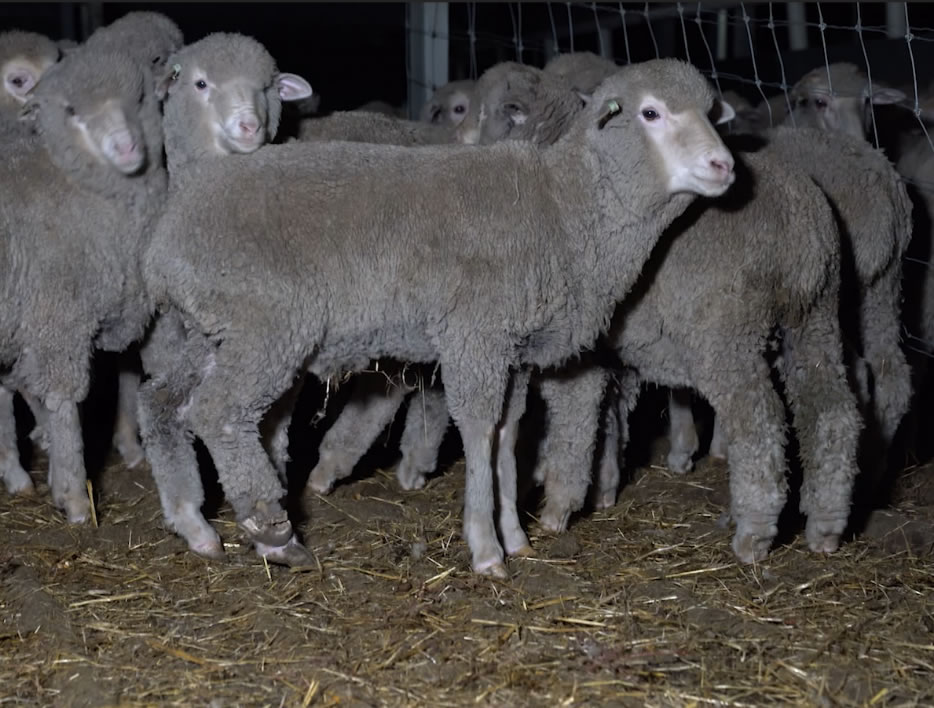 Sheep with badly injured foot.
Sheep with badly injured foot.
Acidosis
Also known as grain poisoning, acidosis is a huge health concern for sheep and lambs housed in feedlots. This painful condition occurs mostly in animals who have a low fibre (grass/hay), high fermentable carbohydrate (grain) diets. Grain poisoning accounts for up to 15% of deaths within flocks in intensive finishing systems. Sheep and lambs with severe cases of acidosis have little chance of survival.
Grain poisoning commonly occurs when sheep are given access to grain after being on a high fibre diet. Sheep who are 'finished' in intensive feedlots have their diet changed drastically from grass and hay to grains, therefore sheep and lambs that are moved to intensive finishing systems are at a high risk of experiencing grain poisoning.
Symptoms suffered:
- Abdominal pain
- Absence of Ruminal movements
- Bloating
- Diarrhoea
- Colic
- Dehydration
- Weak pulse
- Slow capillary refill
- Subnormal temperature
Pulpy kidney
Pulpy kidney is most commonly found in heavily grain fed sheep. Pulpy kidney causes sudden death in lambs and sheep. To counteract this, lambs/sheep have to be placed on vaccination programs before they are moved to intensive finishing systems.
Symptoms suffered:
- Kicking
- Frothing at the mouth
- Staggering and Knuckling over
- Brain injury
- Champing of the jaws
- Salivation
- Hyperventilation
- Convulsions
Prolapse
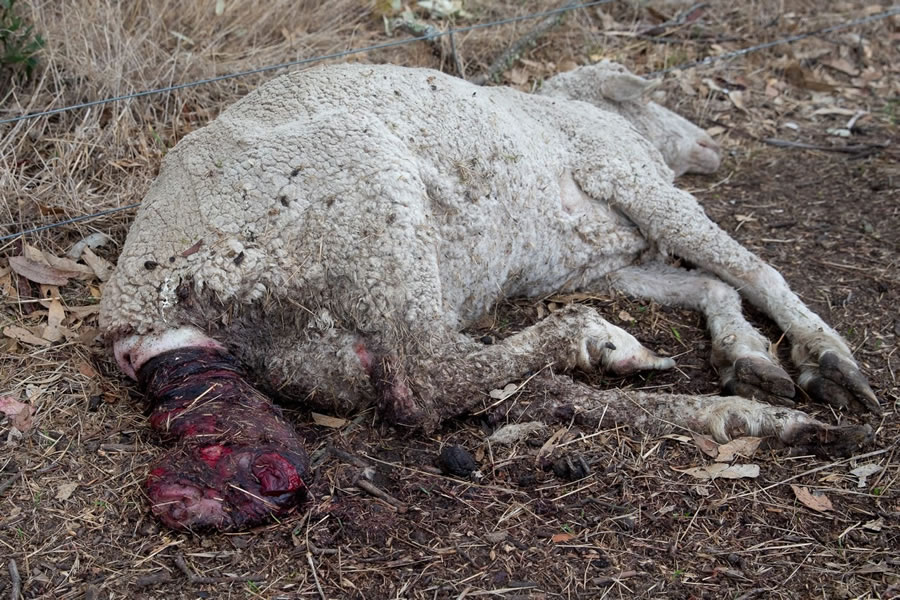 A dead ewe who has prolapsed
A dead ewe who has prolapsed
Rectal prolapse has been found to occur most commonly in sheep and lambs being finished on high concentrate (grain) diets. Lack of adequate fibre in lamb/sheep diets can cause constipation and straining, leading to prolapse. Chronic coughing can also cause prolapse in lambs and sheep in intensive finishing systems. Sheep and lambs in feedlots systems are susceptible to chronic coughing due to the exposure to grain dust in their diet and the increased risk of pneumonia.
Pneumonia
Pneumonia is an acute infectious disease. It occurs commonly in lambs/sheep in intensive feedlot systems due to exposure to dust (particularly grain dust) and irritating gases such as ammonia which is caused by build up of urine.
Meat and Livestock Australia highlight the risk to profit margins that pneumonia poses to farmers rather than the suffering it causes sheep who contract the disease.
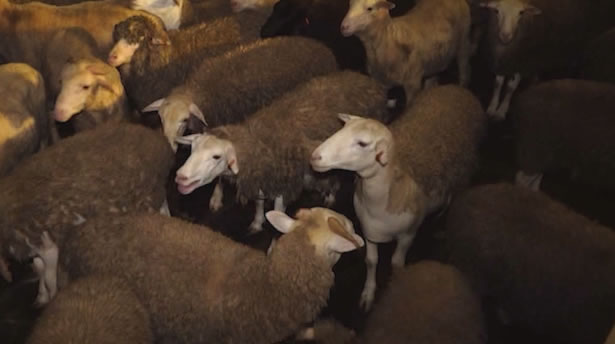
Symptoms suffered:
- Coughing and lameness
- Fever
- Nasal discharge
- Lack of appetite
- Gauntness
- Loss of weight
- Laboured and rapid breathing
Coccidiosis
Coccidiosis is caused by a parasite that can be found in the intestinal wall of infected sheep. Sheep and lambs finished in intensive feedlot systems are susceptible to the parasite due to stress, poor nutrition and overstocking.
Symptoms suffered:
- Anorexia
- Abdominal pain
- Diarrhoea
- Lack of appetite Weakness
- Dehydration
Arthritis
Arthritis, or inflammation of joints, can both be acute and chronic. Arthritis in sheep and lambs occur when the bone surface in one or more joints becomes damaged. Animals in intensive confinement systems are at greater risk due to being housed on surfaces that are hard on their joints.
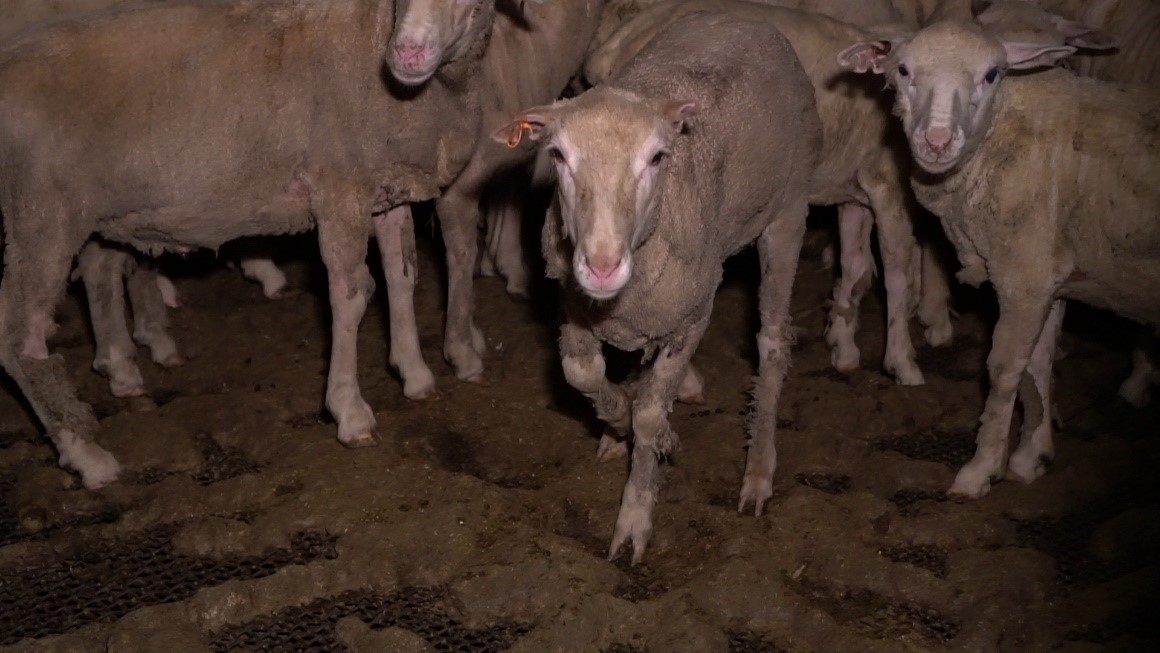 A sheep housed in a feedlot with a leg injury.
A sheep housed in a feedlot with a leg injury.
Other diseases associated with the housing of sheep and lambs in intensive finishing systems include:
- Laminitis
- Bloat (ammonia induced)
- Feed Toxins
- Flies and Parasites
- Mineral Deficiency
- Calcium
- Copper
- Magnesium
- Phosphate
- Potassium
- Sodium
- Zinc
- Nitrate/nitrite poisoning
- Pink eye
- Pleurisy/pneumonia
- Scabby Mouth
- Salmonellosis
- Urea poisoning
- Urinary calculi
- Wool biting
Destruction of sheep
Outlined within the National Procedures and Guidelines for Intensive Sheep and Lamb Feeding systems is the way in which it is suggested sick animals be 'destroyed'.
These can be found in the National procedures and guidelines for intensive sheep and lamb feeding systems,which was published by Meat and Livestock Australia in 2011.
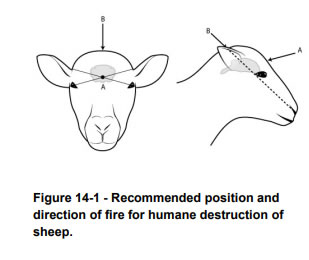 |
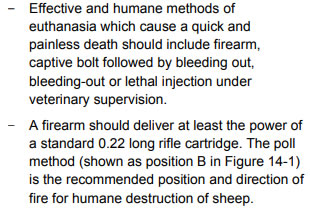 |
(Source: National procedures and guidelines for intensive sheep and lamb feeding systems)
The Accepted Farming Practise for the Welfare of Sheep (Victoria) also outlines that 'blunt trauma' and 'bleeding out' to be acceptable methods of killing sheep/lambs.

Winter Lambing
'Winter lambing' is the practice of impregnating sheep so that they give birth in winter months, meaning their lambs are weaned in spring when pastures are most fertile. While this allows the lambs to grow more quickly, it results in 10-15 million newborn lambs – roughly one in every four – dying within 48 hours of birth from exposure to the harsh cold. For sheep farmers, this is still preferable to the higher feed costs of lambing in warmer months.
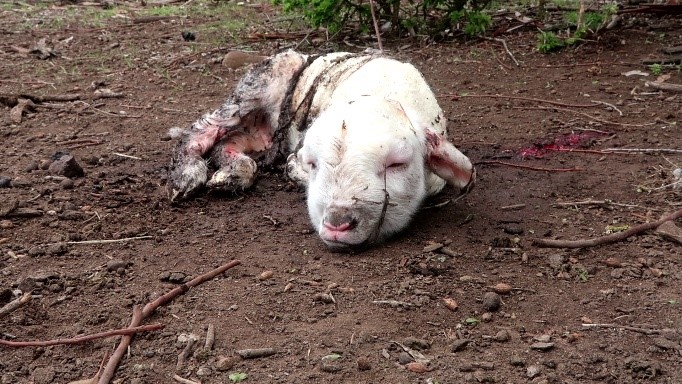 A orphaned lamb on a cold winters' day
A orphaned lamb on a cold winters' day
Selective breeding impacts on lambs
Sheep naturally give birth to one lamb, sometimes two, as with humans. However, years of selective breeding and genetic manipulation has forced sheep to live unnaturally. It is now extremely common for ewes to birth twins, and even triplets are fairly regular occurrences.
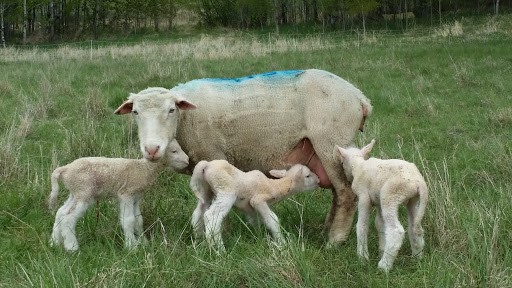
Death rates of lambs increase significantly as more are birthed. Lambs born as twins or triplets are smaller and weaker, so are more likely to die of hypothermia and other complications. Ewes only have two teats to offer their young milk from, so the weakest stand little chance to live in the case of triplets and even quadruplets.
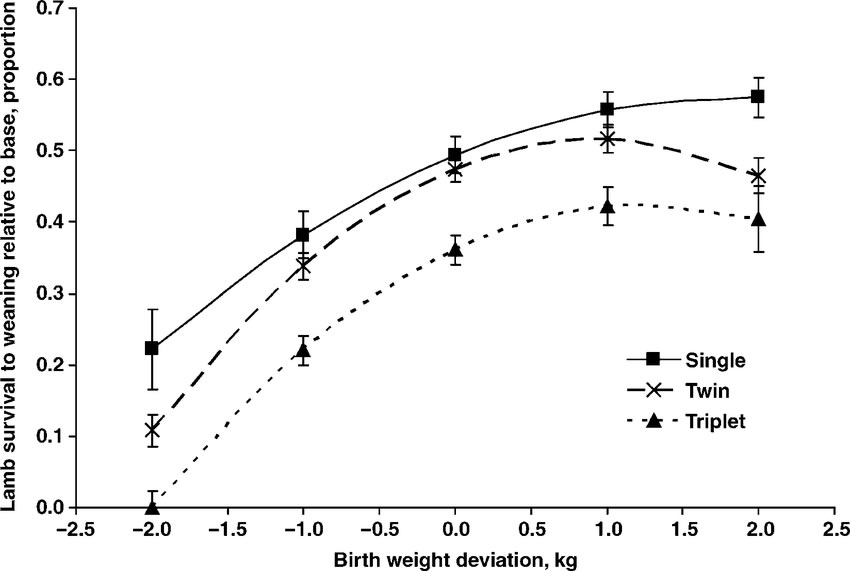
Journal of Animal Science graph showing that twins and triplets are lighter, and more likely to die.
Selective breeding impacts on ewes
Not only has selective breeding led to millions of newborn lambs dying annually, it harms mother ewes. Mother sheep bearing twins and triplets are more likely to die than sheep who are able to birth a natural single lamb.
These ewes are also more likely to become downed, susceptible to becoming fox or crow prey, and to prolapse. This means a ewe's vagina is pushed out of her vulva during lambing, and even her pelvic organs may literally fall out of her. Prolapse regularly leads to death especially in severe cases.
Painful standard practises
Castration
Castration is performed on male lambs who will not be purposed for breeding. Castration is performed without the use of anaesthesia and is an acutely painful procedure.
Outlined within the Code of Accepted Farming Practice for the Welfare of Sheep (Victoria):
"Acceptable methods of castrating male lambs without anaesthesia are by:
(a) cutting: the lamb should be properly restrained and the knife (cutting instrument) should be kept clean and sharp; good post-operative drainage of the wound is required;
(b) rubber rings applied according to the manufacturers recommendation"
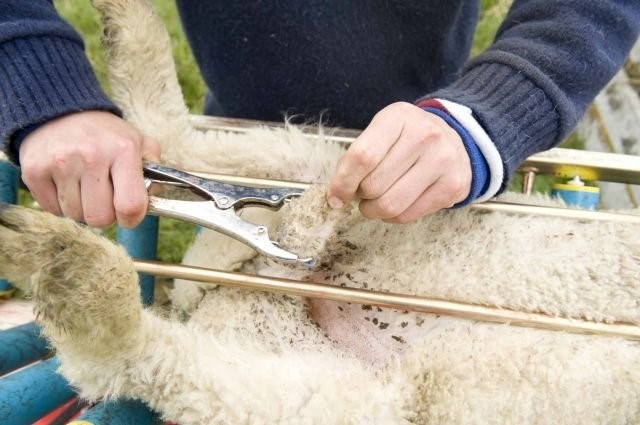 A lamb being castrated. Source: Source: VetMarker
A lamb being castrated. Source: Source: VetMarker
Tail Docking
Tail docking is the painful removal of lambs tails in order to prevent fly strike. Fly strike is an infestation of the skin by developing larvae (maggots). This is the cheapest and least time-consuming way for farmers to manage the risk of fly strike, there are however, kinder methods that eliminate sheep and lamb suffering which are used widely in animal sanctuaries. However, with elevated cost and more time required, these methods are not considered best practise.
Outlined in the Code of Accepted Farming Practice for the Welfare of Sheep (Victoria) 'Acceptable methods of tail docking, without anaesthesia, are; cutting with sharp knife; applying rubber rings according to the manufacturer's recommendation; or using a gas flame heated scarring iron according to the manufacturers recommendations'
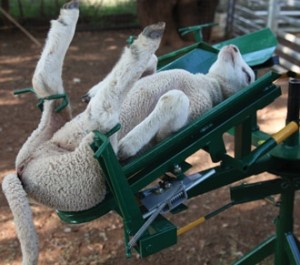 During mutilations like tail docking, lambs are held in 'cradles' which restrain them. This lamb is about to have her tail cut off.
During mutilations like tail docking, lambs are held in 'cradles' which restrain them. This lamb is about to have her tail cut off.
Mulesing
Mulesing is the practice of cutting off the skin around a lamb's buttocks with metal shears. Mulesing was introduced in order to prevent fly strike. Mulesing can be performed on lambs up to 6 months of age without the use of anaesthetic.
Mulesing is not a necessity in order to prevent fly strike, however it is the easiest and most cost-effective way for farmers to do so as they cannot adequately monitor their entire flock.
Many sheep that live in sanctuaries have never been subjected to the practice and with appropriate monitoring and care fly strike can be prevented without this painful procedure, however it is more time consuming and costly.
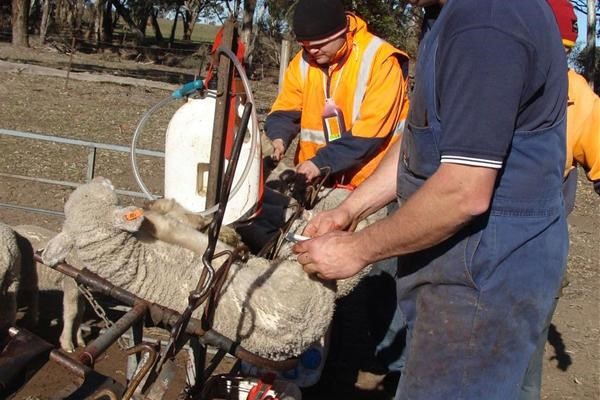 A lamb restrained for mulesing. Source: APS Information Site for Cacb
A lamb restrained for mulesing. Source: APS Information Site for Cacb
The Wool industry
Sheep and lambs kept in intensive confinement systems are not only exploited for their flesh, they are often exploited for their wool too.
The sheep industry exists to make a profit from both sheep wool and flesh. 70% of Australia's sheep populations are merinos, commonly considered 'wool sheep', yet they will all be slaughtered for their flesh as well. Most of the rest of the sheep population are merino cross breeds, considered 'dual-purpose' as both their wool and flesh are sold for profit. Some sheep, whether pure merino or otherwise, are slaughtered as young lambs, sometimes shorn before. Others are shorn regularly until they are about 5-6 years old, in which case they are 'cast for age' and slaughtered. These sheep are often sold into live export to countries where mutton meat is consumed at a higher rate.
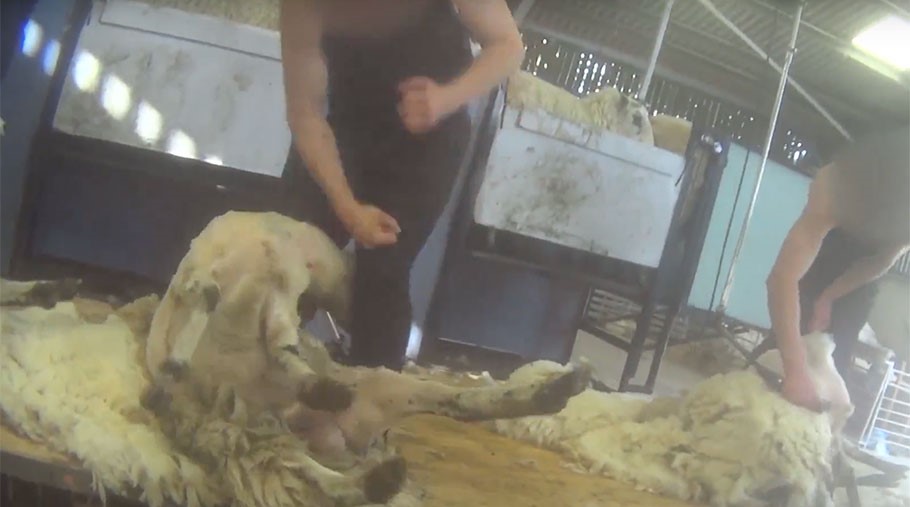 Sheep being beaten during sheering process Source: Peta Asia
Sheep being beaten during sheering process Source: Peta Asia
Shearers are normally paid 'per head' or by the weight of the wool shorn. For this reason, speed means greater profits, even when this creates stress and physical danger for sheep who are being shorn. In previous investigations, sheep have been found to be shorn in as little as 3 minutes. PETA Asia's exposé into the Australian wool industry revealed extreme cruelty and rough handling of sheep. In the vision sheep are seen to be punched, thrown, stomped on, and regularly cut whilst being shorn, with shearers subsequently stitching the wounds up themselves.
Peta Asia's investigation into the Australian Wool Industry.
Learn more in the Wool section of the knowledgebase
Environmental impact of sheep feedlots
A paper published by the CSIRO in 2004 explores the potential environmental hazards intensive feedlotting systems can pose. The paper concluded there was inadequate research that appropriately quantified just how much environmental damage these systems are causing. The climate emergency is one of the most pressing issues of our time, and such complacency is irresponsible.
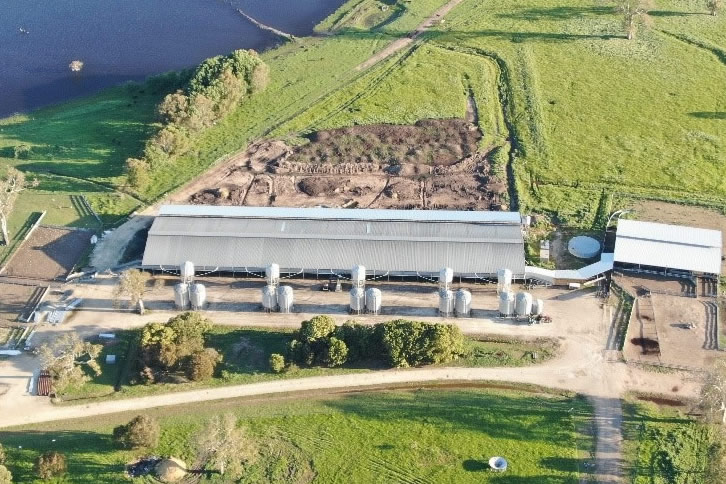 A drone image above an intensive confinement system housing sheep.
A drone image above an intensive confinement system housing sheep.
There is potential for leaching and run off caused by increased nutrient levels in the soil. In outdoor systems there is also great risk of water and air erosion as the surface of the soil is loosened and exposed by sheep/lamb hooves. For every kilogram of animal meat consumed by humans, 20 kilograms of manure is produced. Noxious gases are produced by decomposition of manure which is harmful to the environment and animal health. Effluent run off can contaminate waterways with excess nutrients and pathogens.
Methane production:
Methane is a greenhouse gas that is roughly 30 times more potent than CO2 emissions as a heat trapping gas and has a global warming rate 86 times that of CO2 within a 20 year time frame. Livestock animals produce methane whenever they pass gas or burp. The livestock sector worldwide contributes 18 percent of greenhouse gas emissions, which is higher than the total transport system combined.
Further References:
Disease, market, destruction, export, stocking densities:
https://www.wool.com/market-intelligence/sheep-numbers-by-state/
https://www.agriculture.gov.au/export/controlled-goods/meat/statistics/archive#2012
https://www.agriculture.gov.au/abares/research-topics/agricultural-outlook
Environmental impacts
https://www.publish.csiro.au/sa/pdf/SA0401011
https://www.cowspiracy.com/facts
Slaughter and cast for age
https://www.woolwise.com/wp-content/uploads/2017/07/Wool-412-512-08-T-01.pdf
Winter lambing:
https://www.researchgate.net/publication/277683724_Lamb_survival_in_Australian_flocks_A_review


